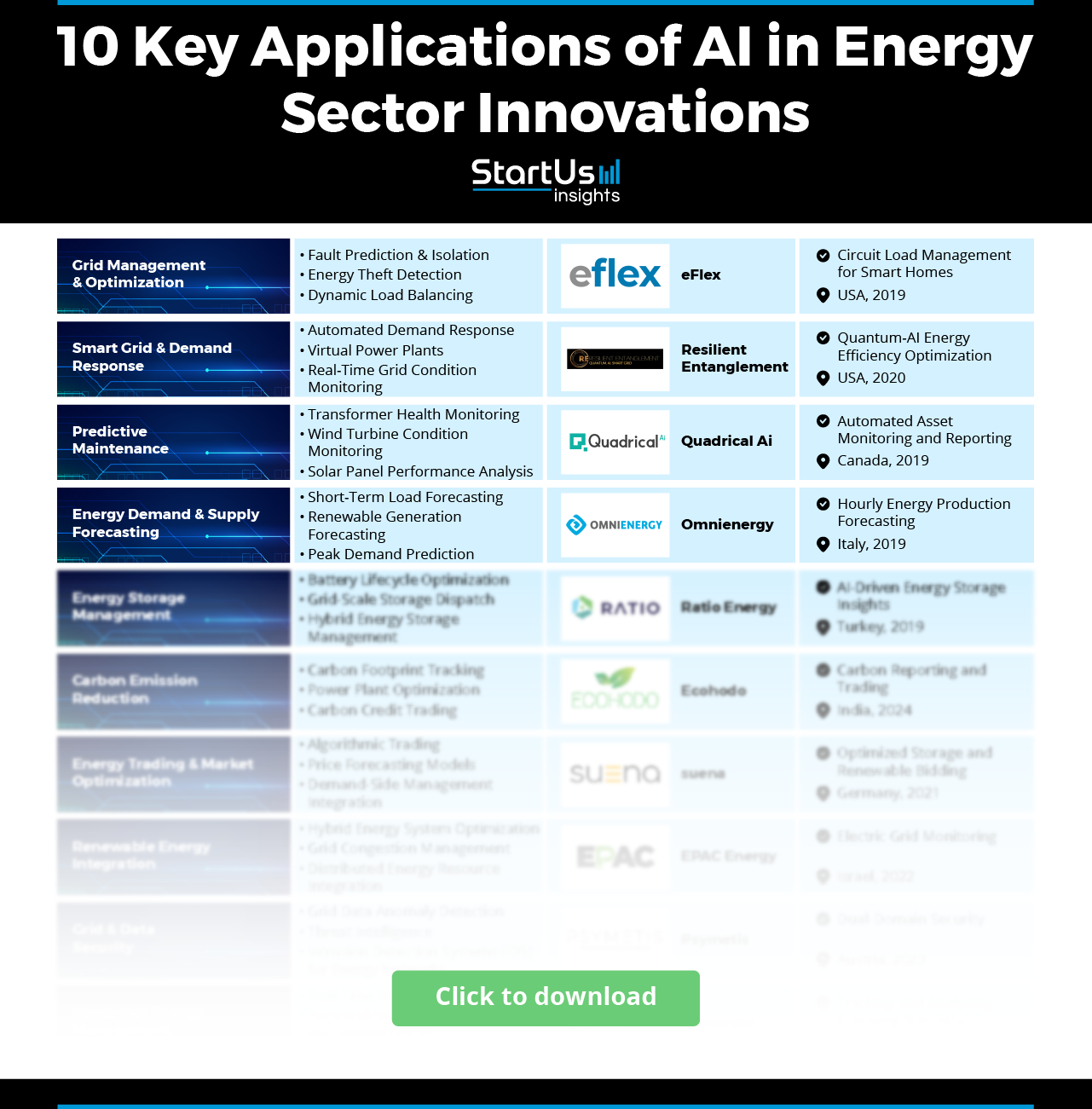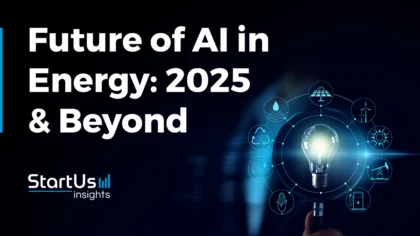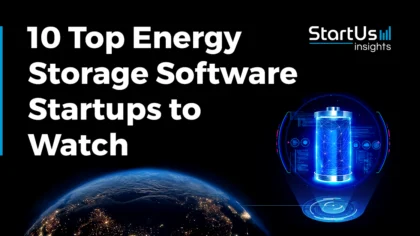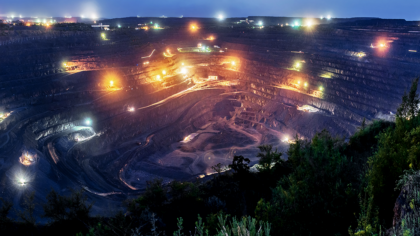Accelerate Productivity in 2025
Reignite Growth Despite the Global Slowdown
Artificial Intelligence (AI) is addressing challenges related to grid stability, renewable integration, and operational efficiency in the energy sector. Through analytics, real-time monitoring, and machine learning algorithms, AI offers predictive maintenance and improves power distribution and energy storage management. These technologies allow energy-focused startups to forecast demand and supply fluctuations, prevent equipment failures, and reduce carbon emissions. This article explores the top 10 applications of AI in energy and how the technology is driving the transition toward a sustainable, resilient, and efficient energy future.
Why should you read this report?
- Gain insights into the top 10 applications of AI in energy.
- Learn about three practical use cases for each application.
- Meet 10 innovative startups advancing these applications.

Key Takeaways
- Grid Management & Optimization
- Use Cases:
- Fault Prediction & Isolation
- Energy Theft Detection
- Dynamic Load Balancing
- Startup to Watch: eFlex
- Use Cases:
- Smart Grid and Demand Response
- Use Cases:
- Automated Demand Response
- Virtual Power Plants
- Real-Time Grid Condition Monitoring
- Startup to Watch: Resilient Entanglement
- Use Cases:
- Predictive Maintenance
- Use Cases:
- Transformer Health Monitoring
- Wind Turbine Condition Monitoring
- Solar Panel Performance Analysis
- Startup to Watch: Quadrical Ai
- Use Cases:
- Energy Demand and Supply Forecasting
- Use Cases:
- Fault Prediction & Isolation
- Energy Theft Detection
- Dynamic Load Balancing
- Startup to Watch: Omnienergy
- Use Cases:
- Energy Storage Management
- Use Cases:
- Fault Prediction & Isolation
- Energy Theft Detection
- Dynamic Load Balancing
- Startup to Watch: Ratio Energy
- Use Cases:
- Carbon Emission Reduction
- Use Cases:
- Carbon Footprint Tracking
- Power Plant Optimization
- Carbon Credit Trading
- Startup to Watch: Ecodoho
- Use Cases:
- Energy Trading and Market Optimization
- Use Cases:
- Algorithmic Trading
- Price Forecasting Models
- Demand-Side Management Integration
- Startup to Watch: Suena
- Use Cases:
- Renewable Energy Integration
- Use Cases:
- Hybrid Energy System Optimization
- Grid Congestion Management
- Distributed Energy Resource Integration
- Startup to Watch: EPAC Energy
- Use Cases:
- Grid & Data Security
- Use Cases:
- Grid Data Anomaly Detection
- Threat Intelligence
- Intrusion Detection Systems (IDS) for Energy Networks
- Startup to Watch: Psymetis
- Use Cases:
- Consumer Energy Management
- Use Cases:
- Real-Time Usage Alerts
- Personalized Energy Usage Recommendations
- Smart Home Integration
- Startup to Watch: Wenerate
- Use Cases:
FAQs: Applications of AI in Energy
1. How is artificial intelligence used in the energy industry?
Artificial intelligence is transforming the energy sector by optimizing grid operations, predicting energy demand, and improving the integration of renewable sources like wind and solar. AI increases energy efficiency in buildings, automates energy trading, and enables predictive maintenance for power infrastructure. It also plays a key role in reducing carbon emissions by identifying energy-saving opportunities and optimizing energy use which drive the shift toward a more sustainable energy future.
2. Can AI solve the energy crisis?
AI analyzes consumption patterns to predict peak demand and reduce waste. This also enables companies to stabilize the grid, especially when managing intermittent sources like wind and solar. In production, AI improves fossil fuel extraction and renewable energy systems. It increases extraction efficiency while minimizing environmental impact and offers predictive maintenance for energy assets.
Additionally, AI strengthens smart grid management and decentralized energy systems by improving grid balancing and microgrid autonomy. All these assist the industry in addressing the energy crisis and transition to a low-carbon economy. These technologies assist the energy industry to address the energy crisis and transition to a low-carbon economy.
Where is this data from?
StartUs Insights gathers data through its exhaustive Discovery Platform, covering information on 4.7 million startups, scaleups, and tech companies globally, alongside 20,000 emerging technologies and trends. The Discovery Platform accelerates startup and technology scouting, trend intelligence, and patent searches, offering thorough insights into technological advancements. By leveraging the trend intelligence feature for this report, we identified emerging technologies within specific industries. This process allows us to uncover patterns and trends, and pinpoint relevant use cases and the startups creating solutions for each scenario. Additional capabilities and information can be found at StartUs Insights Discovery Platform.
Top 10 Applications of AI in Energy Sector [2025 & Beyond]
1. Grid Management & Optimization
Artificial intelligence tackles the complexities of maintaining consistent power supply and demand, predicting equipment failures, and integrating renewable sources. Machine learning forecasts power fluctuations to shift power loads and prevent blackouts. AI algorithms detect irregularities in grid operations that reduce downtime and maintenance costs. Besides, AI integrates with Distributed Energy Resource Management Systems (DERMS) to coordinate multiple energy sources and battery storage for grid stability. IoT integration with AI offers real-time data to improve asset performance. Additionally, these solutions lead to more resilient and sustainable energy management.
Noteworthy Example: Schneider Electric is applying AI in grid management to gather real-time data and predict energy demand, detect faults, and optimize energy distribution. The company’s EcoStruxure Advanced Distribution Management System (ADMS) uses AI for better load forecasting and restoration times. Integrated with ArcFM and DERMS, this platform also allows utilities to securely manage distributed energy resources and adapt to growing solar, wind, and EV use.
3 Practical Use Cases of AI for Grid Management and Optimization
- Fault Prediction & Isolation: AI predicts and isolates potential faults in grid before disruptions occur to improve reliability and enable preemptive maintenance.
- Energy Theft Detection: Finding anomalies in energy consumption patterns allows energy companies to identify potential theft and reduce losses.
- Dynamic Load Balancing: Variable load balancing manages energy distribution on real-time demand across the grid to improve power flow and prevent overloads.
Startup to Watch: eFlex
US-based company Eflex improves grid management and energy use with its device, Clean Energy Smart Panel. This device monitors production and consumption while reducing non-critical loads based on customer priorities. It also features a flexible energy system that allows for compatibility with existing panels and supports three-phase operations. Additionally, the startup’s companion app features a slider system that automates background functions for controlling and monitoring energy consumption. Eflex’s clean energy module integrates easily with standard line-voltage loads and energy sources, including solar inverters and battery storage systems.
2. Smart Grid and Demand Response
Power load balancing, grid security, and renewable energy intermittency are major challenges in the energy sector. AI predicts peak demand to prevent overloads and safeguard grid infrastructure. AI-powered demand response systems communicate with smart devices to adjust electricity usage and reduce strain during peak hours. Additionally, reinforcement learning solutions dynamically allocate resources for renewable integration. AI also identifies equipment issues to avoid outages and maintain grid health. These solutions improve efficiency while lowering operational costs for utilities and consumers.
Noteworthy Example: Researchers at Argonne National Laboratory are using machine learning to improve grid planning and operations. Their models simulate electric systems and predict potential failures, even with complex scenarios.
3 Practical Use Cases of AI for Smart Grid and Demand Response
- Automated Demand Response: Controls adjustments in energy usage based on grid conditions and pricing signals. This optimizes energy consumption during peak periods, reducing costs and stress on the grid.
- Virtual Power Plants: Combine multiple distributed energy resources (DERs) to function as a single power plant for increasing flexibility and ensuring a stable energy supply.
- Real-Time Grid Condition Monitoring: AI systems monitor grid conditions in real time to detect abnormalities. This allows operators to respond swiftly to changes and maintain grid stability.
Startup to Watch: Resilient Entanglement
Resilient Entanglement is a US-based company that offers quantum AI-powered software for the energy industry. The company redesigns the traditional power grid through a suite of products that manage energy management and improve decision-making for utility firms. Its Quantum-Security-Constrained Unit Commitment (Q-SCUC) framework integrates network security constraints with standard scheduling algorithms to improve daily power market planning.
Additionally, the Quantum-Energy Management platform (Q-EMS) provides real-time insights into utility networks for operators to reduce waste and identify maintenance issues proactively. Further, the company also has a solution for Quantum-Optimal Power Flow (Q-OPF) that facilitates critical numerical analyses and economical dispatch strategies for power systems. The startup also follows Quantum-Security Constrained Optimal Power Flow (Q-SCOPF) approach to improve economic operations by minimizing generation costs within the grid’s physical constraints.
3. Predictive Maintenance
Predictive analytics solutions forecast equipment failures analyzing real-time and historical sensor data to detect wear patterns. AI systems analyze vibration data, temperature, and other factors to detect wear in wind turbines. These systems also track energy output and weather patterns to identify underperforming solar panels. Further, these approaches improve reliable power delivery and reduce maintenance expenses for utility companies.
Noteworthy Example: Enedis has implemented AI technologies to increase the reliability and efficiency of its high-tension electrical grid.
3 Practical Use Cases of AI for Predictive Maintenance
- Transformer Health Monitoring: AI analyzes transformer data to predict failures before they happen. This prevents unexpected outages and prolongs equipment life.
- Wind Turbine Condition Monitoring: Assesses turbine performance and identifies potential issues with AI. The integration of artificial intelligence enables timely maintenance, minimizes downtime, and improves energy output.
- Solar Panel Performance Analysis: AI tracks solar panel efficiency and detects faults early. This approach offers maximum energy generation and reduces repair costs.
Startup to Watch: Quadrical Ai
Canadian startup Quadrical Ai builds a predictive maintenance platform that uses digital twin technology to improve the performance of solar and energy storage assets. The platform utilizes real-time data and machine learning to create digital replicas of energy plants for precise monitoring and anomaly detection. By simulating the behavior of individual components such as inverters and panel strings, the platform identifies performance issues and generates automated maintenance tickets prioritized by revenue impact. This approach offers continuous asset optimization, minimizes downtime, and maximizes return on investment for energy operators.
4. Energy Demand and Supply Forecasting
Maintaining grid stability, allocating resources, and managing data overload are some of the major issues in the energy sector. Machine learning algorithms accurately predict energy demand by analyzing historical data and trends while predictive analytics forecasts supply variations based on weather patterns and consumption behaviors. These technologies create a more reliable and efficient energy system that benefits providers and consumers alike.
Noteworthy Example: Siemens’ smart infrastructure uses AI-driven analytics within its grid software to develop a digital twin of the network to predict energy supply and demand fluctuations.
3 Practical Use Cases of AI for Energy Demand and Supply Forecasting
- Short-Term Load Forecasting: Forecasting energy demand for the immediate future based on historical data and weather patterns allows energy providers to plan supply and avoid shortages.
- Renewable Generation Forecasting: Predicting the output of renewable sources like wind and solar allows companies to integrate renewables into the grid and balance the supply.
- Peak Demand Prediction: AI identifies when peak energy demand occurs to enable proactive management and reduce the need for costly peak-time energy purchases.
Startup to Watch: Omnienergy
Italian startup Omnienergy improves energy demand and supply forecasting through its innovative AI-driven platform, Orchestra. It employs a meta-model that dynamically adjusts the contributions of various models to forecast accuracy in real-time. By using multiple forecasting approaches, including weather models and autoregressive techniques, Orchestra reduces imbalance charges. This results in increased profits and operational efficiency.
5. Energy Storage Management
AI addresses challenges such as integrating renewable energy sources, optimizing grid operations, and improving system resilience in energy supply and demand. They manage large-scale energy storage systems by forecasting demand and supply fluctuations to determine the optimal times to store or release energy for grid stability. Additionally, AI coordinates the operation of batteries, flywheels, and compressed air systems to maximize performance through hybrid management. Further, the integration of these AI solutions leads to reduced energy waste, lower operational costs, and increased reliability.
Noteworthy Example: Tesla uses AI to manage energy flow in their battery systems to store excess energy and deploy during peak demand.
3 Practical Use Cases of AI for Energy Storage Management
- Battery Lifecycle Optimization: Machine learning monitors battery usage to improve charging and discharging cycles. This maximizes battery lifespan and energy storage efficiency.
- Grid-Scale Storage Dispatch: AI determines the best times to charge or discharge grid-scale storage systems to maintain grid stability and manage supply-demand imbalances.
- Hybrid Energy Storage Management: Coordinate multiple storage technologies like batteries and supercapacitors with AI systems to ensure optimal performance./li>
Startup to Watch: Ratio Energy
Turkish startup Ratio Energy increases energy storage management through its solutions, RatioSIM and RatioEMS. The company’s technology integrates energy storage systems and distributed energy resources (DERs) which include renewable energy sources like solar and wind, as well as battery storage by leveraging AI for precise financial analysis and operational efficiency.
RatioSIM provides in-depth insights into project viability with key metrics such as Return on Investment (ROI), Net Present Value (NPV), Levelized Cost of Storage (LCOS), and Levelized Cost of Energy (LCOE). The solution also offers granular energy data, including cycle times and State of Charge (SoC) distributions, to support informed decision-making. RatioEMS is a vendor-agnostic energy management platform that features an automated trading system, facilitating efficient energy transactions across various platforms.

6. Carbon Emission Reduction
Energy companies face challenges from fluctuating supply and demand, high carbon emissions, and stringent regulations. Predictive analytics forecast energy consumption trends, allowing companies to optimize supply and reduce waste. AI-driven smart grids effectively integrate renewable energy sources, contributing to lower carbon footprints while increasing grid reliability and efficiency.
This approach meets regulatory standards and promotes sustainable practices in energy managementon predictive analytics and AI in the energy sector. Further, real-time monitoring systems track emissions and energy usage to ensure regulatory compliance. Machine learning analyzes operational data to pinpoint inefficiencies and propose emissions reduction strategies. These technologies bring resource efficiency, support compliance, and promote a sustainable energy landscape.
Noteworthy Example: Google uses artificial intelligence in its data centers to optimize cooling systems and power consumption which reduces energy waste and increases operational efficiency.
3 Practical Use Cases of AI for Carbon Emission Reduction
- Carbon Footprint Tracking: AI monitors energy usage and associated emissions in real-time for with analytical AI systems. This allows energy companies to reduce their carbon footprint.
- Power Plant Optimization: Integrating artificial intelligence improves the operation of power plants to reduce fuel consumption and emissions. This improves plant efficiency and supports sustainability goals.
- Carbon Credit Trading: Analyzing carbon credit markets and identifying optimal trading opportunities to offer better financial returns and support compliance with emission regulations.
Startup to Watch: Ecohodo
Ecohodo is an Indian company that empowers the carbon market ecosystem with digital tools designed for transparency and accuracy in carbon emission reduction. The company offers a Carbon Marketplace for trading verified carbon offset projects. It also offers an automated GHG emissions reporting tool called GHGsync, and TrueMRV, an AI-enabled tool for digital monitoring, reporting, and verification (dMRV). Ecohodo’s Carbon Marketplace allows users to trade carbon credits through a thorough 19-point due diligence process for each project. GHGsync simplifies GHG emissions management by streamlining data collection and reporting for precision across all sectors. Meanwhile, TrueMRV improves compliance with carbon market regulations by using AI and machine learning algorithms. The solution enables universal adaptability and offers unmatched transparency.
7. Energy Trading and Market Optimization
The energy industry is leveraging AI to forecast future price trends to make informed decisions. Machine learning algorithms identify patterns in trading data to improve strategies and automate trade execution. Real-time data processing also enables companies to monitor market conditions and make rapid adjustments.
Noteworthy Example: Veritone Energy leverages its patented AI solutions to increase energy distribution by integrating models with real-time weather, demand, and pricing data. This enables utilities to predict the optimal energy supply mix and pricing.
3 Practical Use Cases of AI for Energy Trading and Market Optimization
- Algorithmic Trading: Effective in trading energy assets based on real-time market data, this approach improves market efficiency and profitability for traders.
- Price Forecasting Models: Predict future energy prices based on market trends and external factors to enable informed decision-making and reduce trading risks.
- Demand-Side Management: Integrating demand-side resources like smart appliances into energy markets improves grid flexibility and energy usage.
Startup to Watch: Suena
Suena is a German-based company that improves energy trading and market optimization through its Optimization as a Service platform. It employs forecasting, optimization, and algorithmic trading techniques. These methods integrate multi-market optimization for battery storage and renewables within trading environments. The platform has an autopilot feature that maximizes trading income by optimizing battery dispatch and implementing strategic bidding across power and balancing markets. Plus, the company’s Trading as a Service automates the scheduling of battery assets to achieve maximum returns. Additionally, Suena provides data-driven insights and professional advice through its Analytics service. It focuses on evaluating business cases and improving grid-scale energy storage systems, whether stand-alone or co-located.
8. Renewable Energy Integration
The energy sector faces significant challenges in stabilizing the grid, managing effective energy storage solutions, and addressing data overload issues. AI-driven predictive analytics accurately forecast fluctuations for energy providers to allocate resources and maintain grid reliability. Smart energy management systems use AI algorithms to manage energy flow from distributed energy resources. They store and redirect excess energy to high-demand areas for energy efficiency and grid stability. AI also provides dynamic demand response strategies that adjust consumer energy usage according to real-time supply conditions. Moreover, these technologies promote a more sustainable and reliable energy future.
Noteworthy Example: Aspen Technology offers industrial software solutions, especially for digital grid management. In collaboration with TenneT, the company developed a power management system to improve renewable energy integration into the grid.
3 Practical Use Cases of AI for Renewable Energy Integration
- Hybrid Energy System Optimization: AI improves the usage of multiple renewable sources and storage systems to maximizes energy output.
- Grid Congestion Management: AI manages grid congestion by redirecting renewable energy to less congested areas to improve grid reliability and prevent energy loss.
- DER Integration: Energy companies coordinate distributed resources like solar panels and batteries to increase grid stability and facilitate the use of clean energy.
Startup to Watch: EPAC Energy
Israeli startup, EPAC Energy develops and delivers hardware and software solutions that provide precise grid visibility and control for improving renewable energy integration. Its proprietary E-MPACT software, combined with B2B hardware at the grid edge, enables energy project developers, microgrid owners, and utilities to access detailed grid congestion signals. This combination allows stakeholders to accurately plan energy capacity and improve project outcomes. This system also utilizes AI and machine learning to analyze real-time data.
9. Grid and Data Security
Frequent cyberattacks and data loss or manipulation are the key challenges for energy companies. AI-powered anomaly detection systems analyze real-time grid data to identify patterns that indicate security breaches or equipment failures while machine learning platforms autonomously detect and respond to potential threats. Further, AI-driven predictive maintenance solutions forecast equipment failures using historical and real-time sensor data to reduce unexpected outages. Intelligent access control mechanisms also use AI to authenticate users accessing critical grid infrastructure. Integrating these AI solutions strengthens energy companies’ security and operational stability.
Noteworthy Example: GridLogic boosts cybersecurity in cyber-physical systems by combining hardware and software security with AI-driven analytics. The company secures field control devices and distributed energy resources through multi-factor authentication, encryption, and Root-of-Trust hardware-based authentication.
3 Practical Use Cases of AI for Grid & Data Security
- Grid Data Anomaly Detection: Advanced AI systems identify unusual patterns in grid data that indicate potential security threats. This allows energy providers to respond quickly and prevent disruptions.
- Threat Intelligence: Gathering and analyzing threat intelligence to identify emerging risks allows businesses to strengthen cybersecurity and protect critical infrastructure.
- Intrusion Detection Systems (IDS) for Energy Networks: Actively blocks malicious activities and unauthorized access attempts in energy networks. They also protect critical infrastructure from cyberattacks and ensure safe energy delivery.
Startup to Watch: Psymetis
Psymetis is an Australian company that integrates AI and machine learning technologies to monitor and protect critical infrastructure in real time. It uses the Psymetis Werewolf platform for real-time monitoring and anomaly detection in both physical and cyber domains. The company’s platform detects anomalies and provides contextualized alerts that detail the nature of the threat, its potential impact, and recommended actions. Additionally, analytics and machine learning models support decision-making by suggesting optimal response strategies on historical data and real-time conditions.
10. Consumer Energy Management
Rising energy prices, lack of visibility into their usage patterns, and struggle to adopt renewables are pressing issues for consumers. To tackle them, AI-driven platforms improve heating and cooling based on real-time data to reduce energy consumption and automate energy-saving actions to reduce consumption during peak times. Plus, these AI solutions improve grid stability and support a shift towards sustainable energy use.
Noteworthy Example: ABB has developed AI-driven solutions for energy management in industrial settings, such as steel and cement industries.
3 Practical Use Cases of AI for Consumer Energy Management
- Real-Time Usage Alerts: Allows users to avoid high bills and adjust their consumption patterns.
- Personalized Energy Usage Recommendations: AI analyzes consumer behavior to offer tailored energy-saving tips. This reduces energy costs and promotes efficient usage.
- Smart Home Integration: Integrate smart home devices like thermostats and appliances into energy management systems with AI. This improves automation and optimizes energy use.
Startup to Watch: Wenerate
Wenerate is a Hungarian startup that offers an AI-supported energy management and monitoring system that tracks and analyzes consumption data. It collects data from existing measurement systems. Users expand their capabilities with additional electric submeters, and temperature, and humidity sensors, which can be purchased or rented. The company’s monitoring system continuously analyzes the collected data and verifies limit values. Their system also creates event logs, sends warnings, prepares statements and reports, and provides recommendations for reducing energy consumption. Additionally, Wenerate’s tenders module allows users to identify necessary resources. This enables them to achieve a major annual energy cost savings.
Don’t Miss Out on the Latest AI-powered Energy Innovations
Top investors like Paycheck Protection Program, Y Combinator, Techstars, and Mass Challenge support startups focusing on AI applications in energy industry. They provide crucial funding that drives innovation. This funding majorly spans seed, early-stage VC/series A, and M&A rounds. Whereas, the average funding per round stands at USD 12.1 million, supporting early-stage startups developing AI-powered solutions advancing energy.
Ready to leverage the latest AI-driven energy technologies shaping the future? With StartUs Insights, you gain quick and easy access to over 4.7 million startups, scaleups, and tech companies, along with 20K+ emerging technologies and trends. Our AI-powered search and real-time database provide exclusive solutions that set you apart from the competition.
Industry giants like Samsung, Nestlé, and Magna trust our innovation intelligence tools to lead trends, optimize operations, and uncover new market opportunities. For example, Oscar Cantalejo, the startup program manager at Iberdrola, says “Through collaborating with StartUs Insights, we discovered new startups for pilot projects and are able to find & test new ideas that help us to improve and generate new business opportunities.”
Like them, you can also benefit from our unmatched data, comprehensive industry views, and reliable insights to drive strategic decision-making. Get in touch to learn how our tailored discovery options can accelerate your innovation journey.
Discover All AI-led Energy Technologies & Startups!







